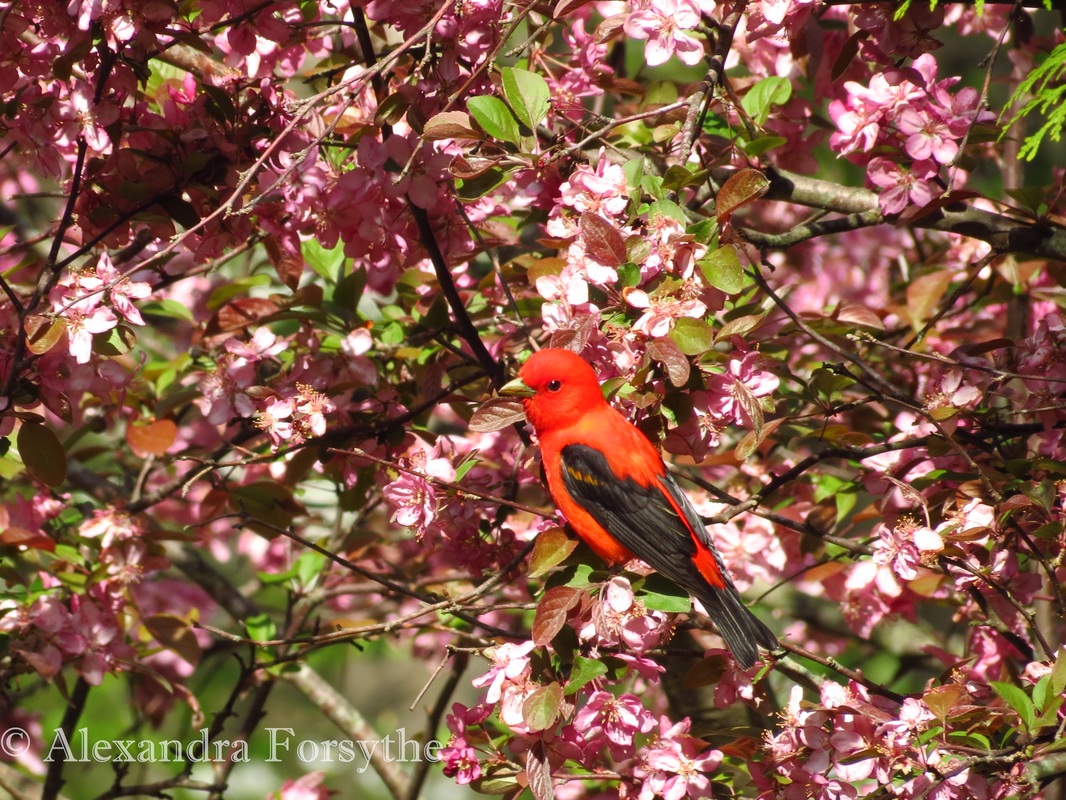
Last Mother's Day, my mom had one request: find her a Scarlet Tanager close enough that she could see it. That's a tall order! They are typically found high in the treetops in forest interiors, and we live in an area in which field corn is usually the tallest plant around! We drove to the next county and found not one, but four male Scarlet Tanagers and 2 females, all down low and easy to see and photograph! It was quite a memorable Mother's Day! Since then we've managed to attract them to our yard. They dine from a mealworm feeder that I set out for Bluebirds. I've also noticed that when I take my mom with me on a birding hike, we now find Scarlet Tanagers more often than not. I think they know she loves them and they appreciate the attention!
My mom loves the Scarlet Tanager primarily for its color. The male is a beautiful crimson with black wings and tail, while the female is equally gorgeous with a yellow-green body and dark wings. Both the male and female sing, but the female's song is quieter and less harsh than the male's song.
Gene Stratton-Porter loved Tanagers, too. She raised and released a Scarlet Tanager while she was writing "Friends in Feathers", and she included the experience near the beginning of that book. The Tanager's nest had been destroyed by a storm and the bird was in danger of either drowning or being trampled by cattle. She took the chick home and dutifully fed it every 15 minutes for ten days. Then she gradually and patiently taught the bird to be self-supporting. She released it in her orchard, feeding and watering it for a while after it fledged, then she slowly reduced the bird's dependence on her. She was sad to see it go, but she knew it was the right thing to do.
The Cornell Lab of Ornithology conducted extensive studies on the Scarlet Tanager in the 1990's resulting in a comprehensive report: "A Land Manager's Guide to Improving Habitat for Scarlet Tanagers and other Forest-interior Birds". It was Cornell's first publication in a series of habitat management guidelines. From 1993 to 1996 over 1,000 volunteers studied Scarlet Tanagers at over 2,000 study sites across North America. At the time, it was one of the largest datasets ever collected on forest fragmentation and birds.
The study found that forest fragmentation negatively affected Scarlet Tanagers, but surprisingly the importance of forest-patch size and isolation of the patches depended largely on the region. In the Midwest, including Indiana, Tanagers are far more affected by fragmentation and require larger tracts of forest in order to survive. According to the study, "roughly 66 acres are required to achieve High Suitability [for Tanager habitat in the Midwest]. As the amount of forest in the surrounding block decreases, the minimum area required by tanagers increases sharply, roughly doubling for every 10% reduction in surrounding forest. Note that in sparsely forested landscapes, the minimum areas required for high and moderate suitability are sometimes impossible to achieve." The study recommends protecting existing forests, reclaiming forest areas, and establishing forested corridors to reconnect isolated forest patches.
Another cause of concern is the Brown-headed Cowbird. If a Cowbird discovers a Tanager's nest near the forest edge, it may lay its egg in the nest, securing the survival of its chick at the expense of the Tanager's chick. Historically, the Brown-headed Cowbird followed the buffalo herds across the plains. As a nomadic species, it could not remain in one location long enough to build a nest and raise its brood. Instead, it was forced to rely on other bird species to raise its young, depositing its eggs in another bird's nest in what is known as "brood parasitism". The Cornell Tanager study points out that the expansion of the Cowbird's range was and is caused solely by humans. With the destruction of the buffalo herds, introduction of cattle and ranches, deforestation of the land, and the ever-increasing agricultural lands, the Cowbirds moved into territories of birds that had no mechanisms for rejecting Cowbird eggs. In addition, the study found that many species require forested areas that are at least 330 feet from a a forest edge; the edge causes an increase in the rate of nest predation and parasitism. The larger the forest patch, the less likely it is for a Cowbird to find a Tanager nest.
Hopefully land owners will adopt the recommendations in Cornell's study. With proper forest management, Scarlet Tanagers could be available on Mother's Day for many years to come, making beautiful memories for moms like mine.
 RSS Feed
RSS Feed
